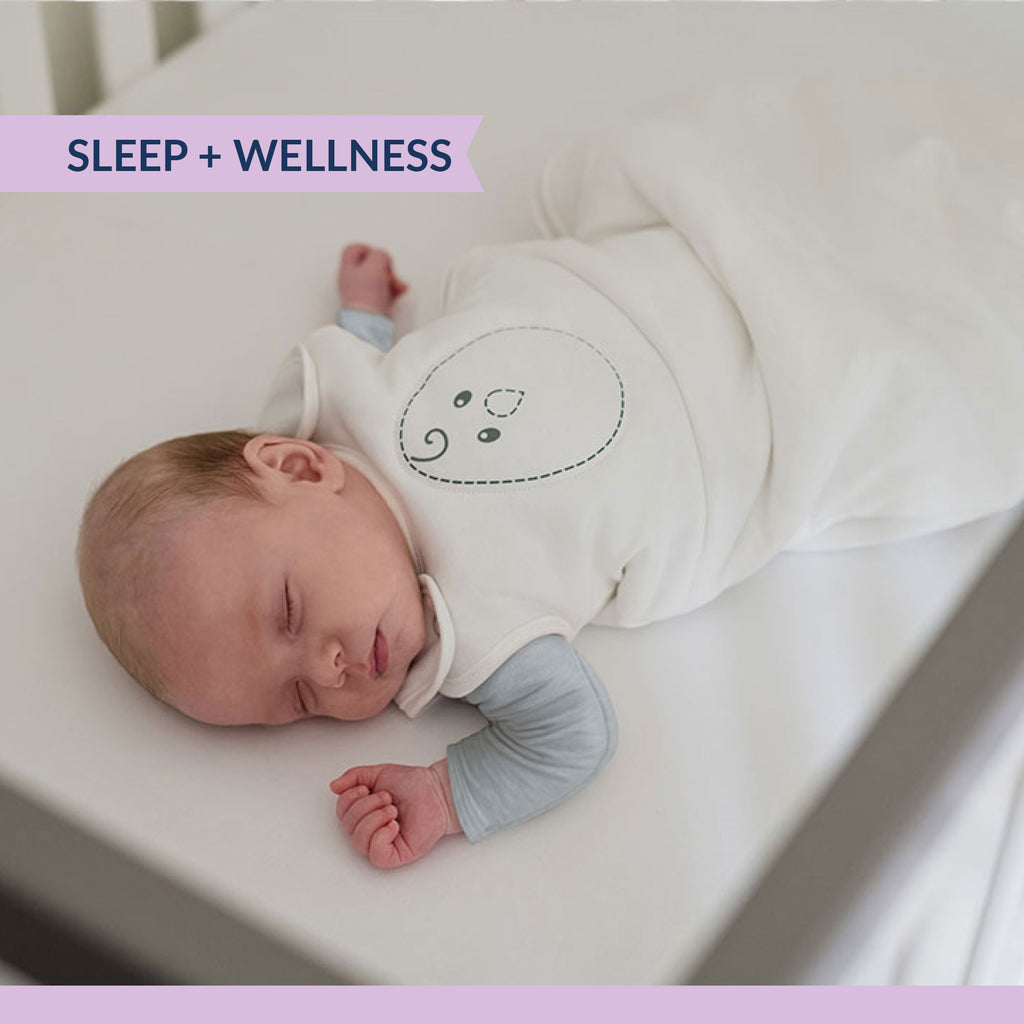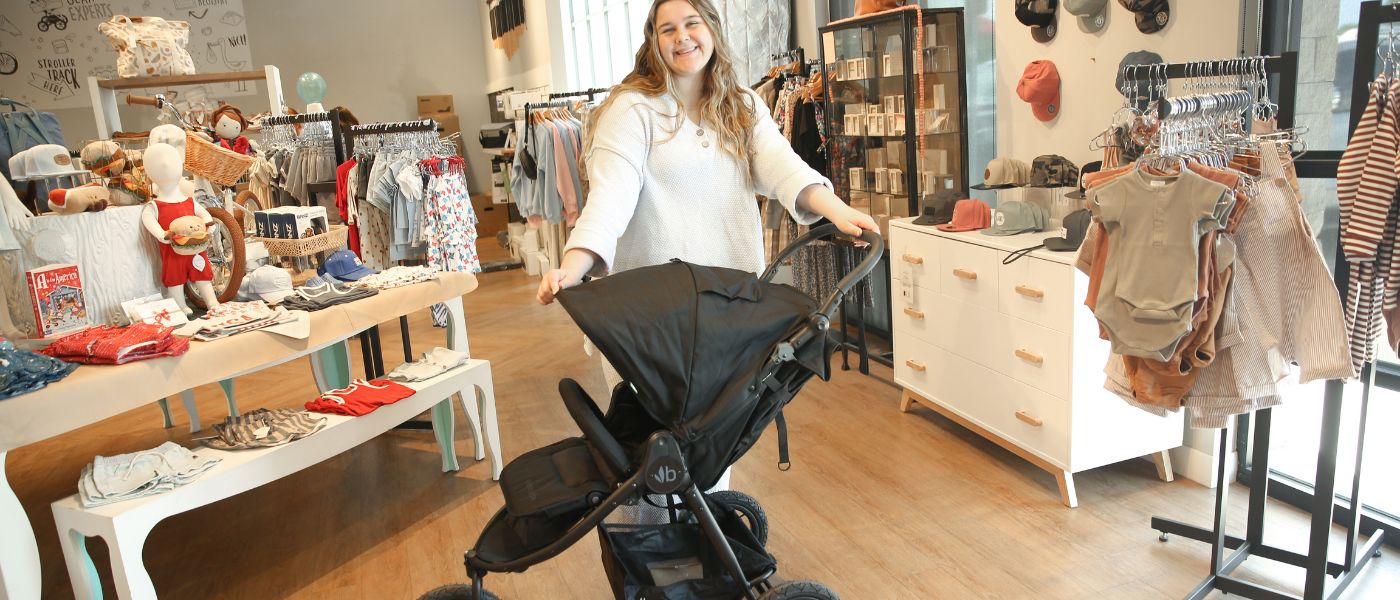When the cold weather sets in, you may start to worry that your little one isn’t warm enough. When babies get cold during the night, they can wake up due to the discomfort – and then it can be difficult for them to fall asleep again.
Unfortunately, blankets are unsafe to be included in a baby’s crib. It’s actually recommended by the American Academy of Pediatrics that until babies are at least 12 months old, their crib should not contain any stuffed toys or loose bedding – not just blankets.
Maybe your child doesn’t like swaddles either or has outgrown theirs. So, how do you keep them warm at night in the winter season?
Luckily, we’ve compiled some advice on how to keep baby warm without a swaddle or blankets. In particular, we’ll have a look at the ideal temperature for a baby’s room, what sleepwear is the most appropriate, and how the right TOG can improve your baby’s sleep.
We’ll also list some great tips for making sure your baby is warm without a blanket, as well as some more safe sleep tips! You can enjoy peace of mind knowing your child is comfy, cozy, and most importantly, safe in our winter sleep sack!
What is the ideal room temperature for a nursery during the winter months?
Just like us grown-ups, babies struggle to sleep if their room is too hot or too cold. In order to keep your little one comfortable and safe, you need to make sure their room or nursery is at the right temperature.
The correct temperature for your baby’s room is considered to be between 68 and 72 degrees Fahrenheit. If you use Celsius, the best room temperature would be between 20 and 22 degrees. The same room temperature actually applies all year round, not just in certain seasons.
It’s very important that your baby’s room isn’t too hot, as when babies overheat, the risk of Sudden Infant Death Syndrome (SIDS) increases. Due to this, you need to be careful not to let them overheat even during the winter.
If your baby’s room doesn’t have a thermostat, you can use an indoor thermometer to keep an eye on the temperature. Aim to keep your room’s temperature within the range we specified above, but remember that you can always make slight changes by dressing your baby in different types of sleepwear.
Signs Your Child May Be Too Cold
Ensuring your baby is neither too hot nor too cold during sleep is crucial for their safety and comfort. While it’s common to worry about overheating, it’s also important to recognize signs that your child may be too cold. Here are key indicators to watch for, along with tips on how to respond:
- Cold to the Touch: Feel your baby’s hands and feet. It’s normal for them to be slightly cooler than the rest of the body, but if they feel unusually cold, it could be a sign that your baby is not warm enough.
- Red or Rosy Cheeks: While this can sometimes be a sign of being overly warm, in a cold environment, rosy cheeks can indicate that your baby’s body is trying to warm itself up.
- Fussiness or Restlessness: A baby who is too cold might be fussier than usual, especially during the night. If you notice your baby is having trouble settling down or is waking up more often than usual, check if the room temperature or their clothing needs adjusting. Learn about the different baby cry meanings in our blog.
- Unusual Lethargy: A cold baby may seem less active or more lethargic than usual. This is a sign that their body is conserving energy to stay warm.
- Cold Skin on the Core Body: Check your baby’s torso and neck to see if their skin feels cooler than usual. The core body temperature is a better indicator of warmth than the extremities.
Any of these signs suggest you need to take steps to warm your child. You can implement the tips below on how to keep baby warm without a swaddle or blankets.
How to Keep Baby Warm Without a Swaddle or Blankets
Keeping your baby warm and safe during the colder months can be a concern for many parents, especially since the use of blankets is not recommended for babies due to safety reasons. Fortunately, there are effective and safe alternatives to ensure your little one stays cozy. Here’s how to keep baby warm without a swaddle or blankets:
- Layered Clothing: Dressing your baby in layers is a flexible and effective way to regulate their body temperature. You can start with a base layer like a cotton bodysuit or onesie, followed by warmer layers such as footed pajamas. The key is to choose breathable fabrics to prevent overheating. You can learn more in our guide on what to dress baby in for sleep.
- Using the Proper TOG-rated Sleepwear: TOG (Thermal Overall Grade) ratings indicate the warmth of baby sleepwear. Our Zen Sack Winter Cotton, for example, is specifically designed for colder temperatures, providing the necessary warmth without the need for additional blankets. It’s important to select a TOG rating that corresponds to the room’s temperature. We’ll get into this in greater detail later on.
- Optimal Crib Placement: Position the crib in a spot that avoids direct exposure to cold drafts from windows, air conditioning, or heating vents. This helps maintain a consistent temperature around your baby’s sleep area.
- Warming the Crib Safely: Pre-warming the crib can make it more inviting for your baby. You can place a hot water bottle or a heating pad in the crib before bedtime. However, it’s crucial to remove it before placing your baby in the crib to avoid overheating or burns.
- Avoiding Head Coverings During Sleep: While hats and head coverings are cute, they are not safe for overnight use as they can lead to overheating and increase the risk of SIDS. It’s best to keep your baby’s head uncovered during sleep to allow for natural heat regulation.
- Room Temperature Monitoring: Keeping the nursery at a comfortable temperature (usually between 68-72 degrees Fahrenheit) is essential, as we discussed earlier. So, it can be as simple as bumping up your thermostat a bit of necessary. Use a room thermometer to monitor and adjust the room’s temperature as needed, as the temperature in your baby’s room may not match that of the rest of the house.
- Hands-on Temperature Checks: Regularly check your baby’s temperature by feeling their neck or back. This will help you gauge if they are too warm or cold and adjust their clothing or room temperature accordingly.
- Safe Bedding: If you’re using a sleep sack like the Zen Sack, ensure it fits well and doesn’t have any loose parts or strings. The sleep sack should allow freedom of movement while keeping your baby snug and warm.
These tips should help you keep your baby warm without blankets or a swaddle. Because much of the attention will be focused on smart clothing shopping and strategic layering, let’s touch on the best practices of what your child should wear to bed.
Best Practices on Dressing Your Child For Sleep
It’s crucial to dress your baby in appropriate sleepwear in order for them to remain safe and comfortable overnight. One of the best ways to make changes to your baby’s temperature is simply by adding or removing a layer of clothing.
A good general rule to follow is that to be comfortable, your baby will need one extra layer than what you’re wearing to bed – if you’re in one layer, your little one will be more comfortable in two.
During cold winter nights, you can try layering your baby in pajamas or a bodysuit in addition to their sleep sack or swaddle. Additionally, to really make sure your little one is at a comfortable body temperature, it’s good to be familiar with the idea of TOG.
What is TOG?
TOG stands for Thermal Overall Grade. It’s a measurement used to show how warm a product is – in this case, we’ll be talking about our range of Zen Sleepwear™. We label our sleepwear with its TOG level so you can know which one your baby needs depending on the temperature.
Let’s have a look at some examples!
Which sleepwear has which TOG?
In the summer months, when the outside temperature is around 75 to 77 degrees Fahrenheit (23 to 25 degrees Celsius), lighter clothing such as our Zen Sack™ Premier Bamboo Rayon Fabric is more appropriate, as it has a low TOG level of 0.3.
Our Zen Sack Classic Cotton weighted sleep sack will suit babies much better when the temperature is more moderate, such as between 64 and 74 degrees Fahrenheit (17 to 22 degrees Celsius). It has a TOG level of 0.5. You could also try our Zen One™ Classic if necessary – its TOG level is a little higher, at 1.0.
During the winter, when indoor temperatures are between 61 and 63 degrees Fahrenheit (15 to 16 degrees Celsius), our Zen Sack Winter Cotton is a great choice – its TOG level is 2.5, meaning it’ll help keep your baby nice and warm.
We also have a bamboo rayon fabric sleep sack that’s perfect for those hot summer nights at a super breezy TOG rating of 0.3. All our Zen Weighted Sleepwear is gently weighted to mimic your touch – this helps soothe them to sleep!
Learn more about the purpose of a sleep sack for babies, the benefits of a sleep sack, what to wear under sleep sack, when to stop using a sleep sack, and how to transition from sleep sack to blanket in our blog. Or, check out this review Becca S. left for our Zen Sack Winter Cotton:
“Our little guy loves his sleepsack. The Winter version is so nice because it keeps him warm. He sleeps for so much longer when he naps in this.”
More tips for safe sleep
When it comes to safe baby sleep, temperature isn’t the only factor to keep in mind. Here are some more tips that you can follow to help reduce the risk of SIDS, and ensure your little one has a safe sleep environment.
It’s important that until your baby is at least 12 months old, they are placed down to sleep on their back, and stay that way through the night (this also applies for naps). Babies should never be placed to sleep on their tummies or on their sides, as this can increase their risk of SIDS.
Share a room with your baby, but don’t share the bed. Sharing the room with your little one for the first six months of their lives can help reduce the risk of SIDS – you’re able to keep an eye on them, make sure they’re comfortable, and feed them.
Sharing a bed, however, can be dangerous and isn’t recommended for babies of any age. You can learn more about cosleeping in our blog and gain our advice on when a baby should sleep in their own room.
Make sure your baby’s mattress is nice and firm, and as we mentioned previously, ensure there is no loose bedding, or any other objects that could be dangerous such as blankets. You should also ensure that your baby doesn’t fall asleep, or isn’t placed down to sleep, in dangerous areas such as on an armchair, couch, pillow, or lounger.
Letting your baby sleep with a pacifier can also reduce the risk of SIDS. If you’re not breastfeeding, feel free to give your baby a pacifier at any point.
If you are breastfeeding though, you should wait a couple of weeks before giving them one, so you can be sure that the breastfeeding is going successfully.
Swaddling your baby is fine as long as you use the proper swaddle technique, so learn how to swaddle a baby in our blog.
We know you came here looking for advice on how to keep baby warm without a swaddle, but if you’re looking for a safe swaddle, we’d recommend our Zen Swaddle® Classic – it’s a gently weighted swaddle that soothes just like your touch. Learn about the benefits of swaddling in our blog.
Final Thoughts on How to Keep Baby Warm Without Blankets or Swaddles
That concludes our guide on how to keep baby warm without blankets or swaddles. From maintaining the nursery temperature between 68-72°F, using TOG-rated sleepwear like our Zen Sack Winter Cotton for colder months, and ensuring the crib is positioned away from drafts, there are many ways you can enjoy peace of mind knowing your child is warm and cozy.
You can learn more about how to help baby sleep through the night in our blog. We’ve covered everything from the signs of sleep regression to when to start sleep training baby, when do toddlers stop napping, home remedies for teething baby at night, newborn bedtime routine, how to hold a newborn, why do newborns sleep so much, and more.
Remember, the right sleepwear, such as Nested Bean’s gently weighted options, can significantly enhance your baby’s comfort and sleep quality. For a cozy, safe sleep environment for your little one, explore our collection at Nested Bean and experience the difference in your child’s sleep tonight!








